Richmond College Health Inequalities Assignment: Sociological Analysis
VerifiedAdded on 2022/12/27
|8
|2211
|1
Homework Assignment
AI Summary
This assignment examines health inequalities through a sociological lens, comparing and contrasting functionalism, conflict theory, and symbolic interactionism. The introduction defines health inequalities and provides examples. The main body includes a comparison table of the sociological perspectives, analyzing their views on health and illness. It then analyzes inequalities in health and illness, focusing on case studies of two families, Jo's and Annabel's, to illustrate the concepts. The assignment uses the functionalist and conflict approaches to explain health inequalities. The conclusion summarizes the multifaceted nature of health and the role of medicine and healthcare. The assignment includes a discussion of how social factors impact health outcomes and access to healthcare. The assignment highlights the impact of social inequalities on health, and provides a comprehensive overview of the subject.
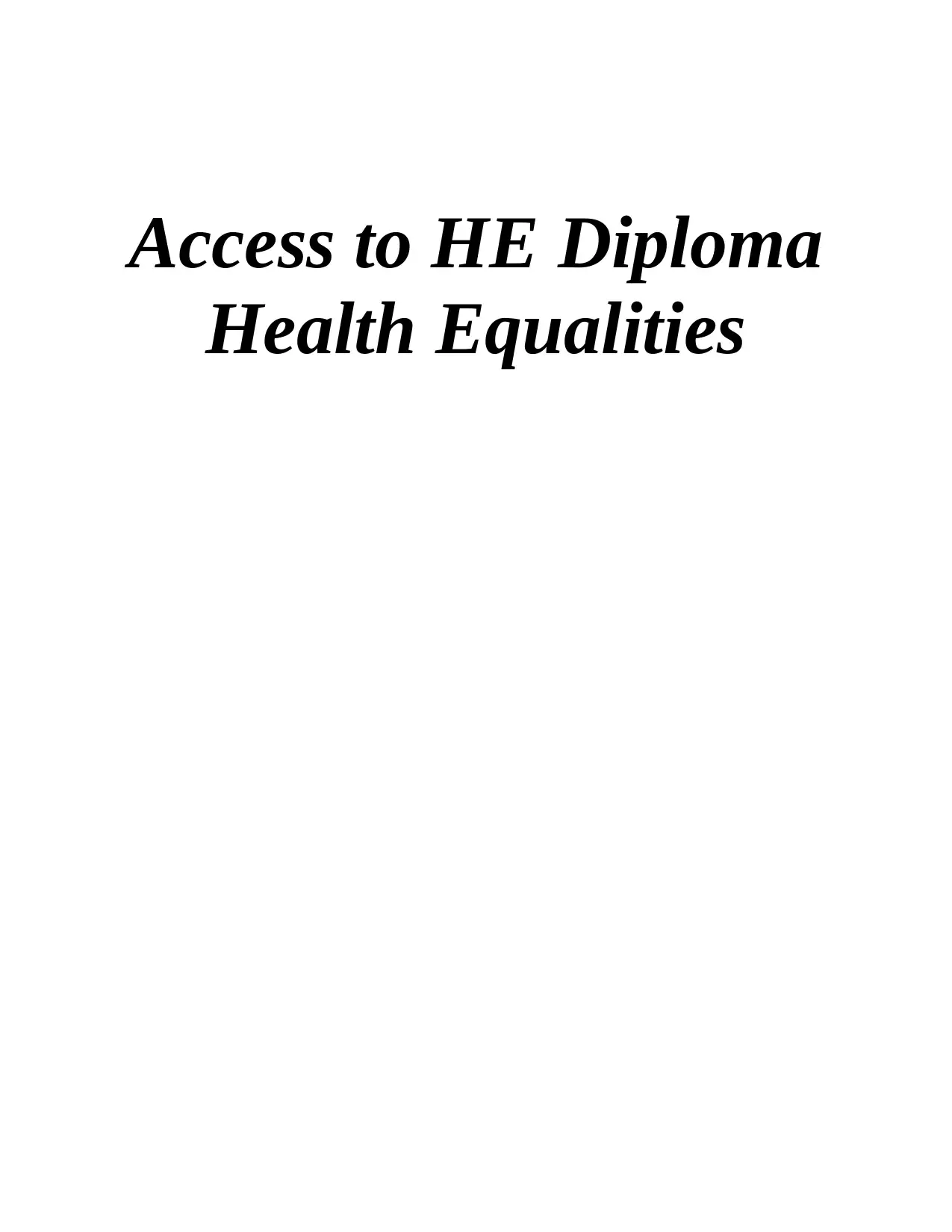
Access to HE Diploma
Health Equalities
Health Equalities
Paraphrase This Document
Need a fresh take? Get an instant paraphrase of this document with our AI Paraphraser
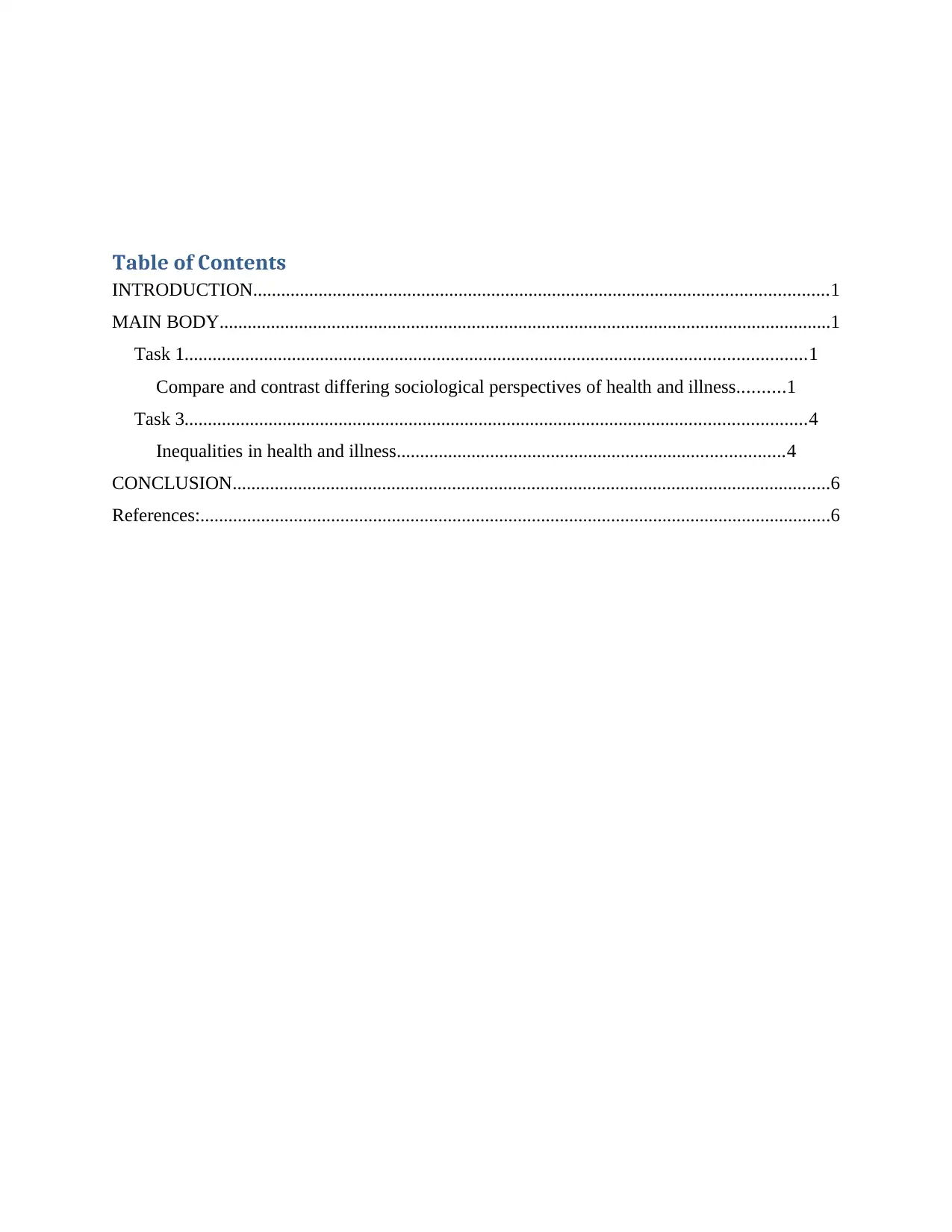
Table of Contents
INTRODUCTION...........................................................................................................................1
MAIN BODY...................................................................................................................................1
Task 1.....................................................................................................................................1
Compare and contrast differing sociological perspectives of health and illness..........1
Task 3.....................................................................................................................................4
Inequalities in health and illness...................................................................................4
CONCLUSION................................................................................................................................6
References:.......................................................................................................................................6
INTRODUCTION...........................................................................................................................1
MAIN BODY...................................................................................................................................1
Task 1.....................................................................................................................................1
Compare and contrast differing sociological perspectives of health and illness..........1
Task 3.....................................................................................................................................4
Inequalities in health and illness...................................................................................4
CONCLUSION................................................................................................................................6
References:.......................................................................................................................................6
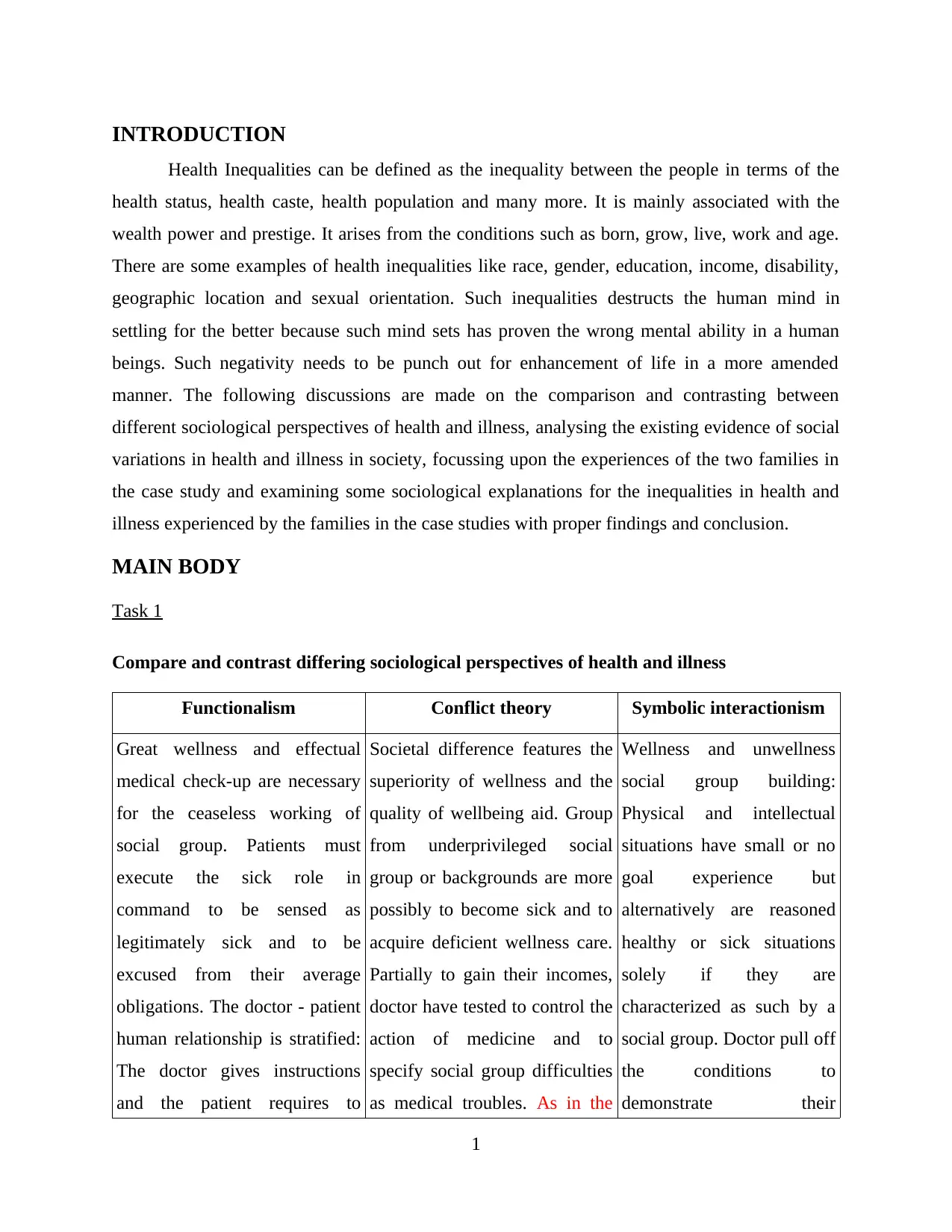
INTRODUCTION
Health Inequalities can be defined as the inequality between the people in terms of the
health status, health caste, health population and many more. It is mainly associated with the
wealth power and prestige. It arises from the conditions such as born, grow, live, work and age.
There are some examples of health inequalities like race, gender, education, income, disability,
geographic location and sexual orientation. Such inequalities destructs the human mind in
settling for the better because such mind sets has proven the wrong mental ability in a human
beings. Such negativity needs to be punch out for enhancement of life in a more amended
manner. The following discussions are made on the comparison and contrasting between
different sociological perspectives of health and illness, analysing the existing evidence of social
variations in health and illness in society, focussing upon the experiences of the two families in
the case study and examining some sociological explanations for the inequalities in health and
illness experienced by the families in the case studies with proper findings and conclusion.
MAIN BODY
Task 1
Compare and contrast differing sociological perspectives of health and illness
Functionalism Conflict theory Symbolic interactionism
Great wellness and effectual
medical check-up are necessary
for the ceaseless working of
social group. Patients must
execute the sick role in
command to be sensed as
legitimately sick and to be
excused from their average
obligations. The doctor - patient
human relationship is stratified:
The doctor gives instructions
and the patient requires to
Societal difference features the
superiority of wellness and the
quality of wellbeing aid. Group
from underprivileged social
group or backgrounds are more
possibly to become sick and to
acquire deficient wellness care.
Partially to gain their incomes,
doctor have tested to control the
action of medicine and to
specify social group difficulties
as medical troubles. As in the
Wellness and unwellness
social group building:
Physical and intellectual
situations have small or no
goal experience but
alternatively are reasoned
healthy or sick situations
solely if they are
characterized as such by a
social group. Doctor pull off
the conditions to
demonstrate their
1
Health Inequalities can be defined as the inequality between the people in terms of the
health status, health caste, health population and many more. It is mainly associated with the
wealth power and prestige. It arises from the conditions such as born, grow, live, work and age.
There are some examples of health inequalities like race, gender, education, income, disability,
geographic location and sexual orientation. Such inequalities destructs the human mind in
settling for the better because such mind sets has proven the wrong mental ability in a human
beings. Such negativity needs to be punch out for enhancement of life in a more amended
manner. The following discussions are made on the comparison and contrasting between
different sociological perspectives of health and illness, analysing the existing evidence of social
variations in health and illness in society, focussing upon the experiences of the two families in
the case study and examining some sociological explanations for the inequalities in health and
illness experienced by the families in the case studies with proper findings and conclusion.
MAIN BODY
Task 1
Compare and contrast differing sociological perspectives of health and illness
Functionalism Conflict theory Symbolic interactionism
Great wellness and effectual
medical check-up are necessary
for the ceaseless working of
social group. Patients must
execute the sick role in
command to be sensed as
legitimately sick and to be
excused from their average
obligations. The doctor - patient
human relationship is stratified:
The doctor gives instructions
and the patient requires to
Societal difference features the
superiority of wellness and the
quality of wellbeing aid. Group
from underprivileged social
group or backgrounds are more
possibly to become sick and to
acquire deficient wellness care.
Partially to gain their incomes,
doctor have tested to control the
action of medicine and to
specify social group difficulties
as medical troubles. As in the
Wellness and unwellness
social group building:
Physical and intellectual
situations have small or no
goal experience but
alternatively are reasoned
healthy or sick situations
solely if they are
characterized as such by a
social group. Doctor pull off
the conditions to
demonstrate their
1
⊘ This is a preview!⊘
Do you want full access?
Subscribe today to unlock all pages.

Trusted by 1+ million students worldwide
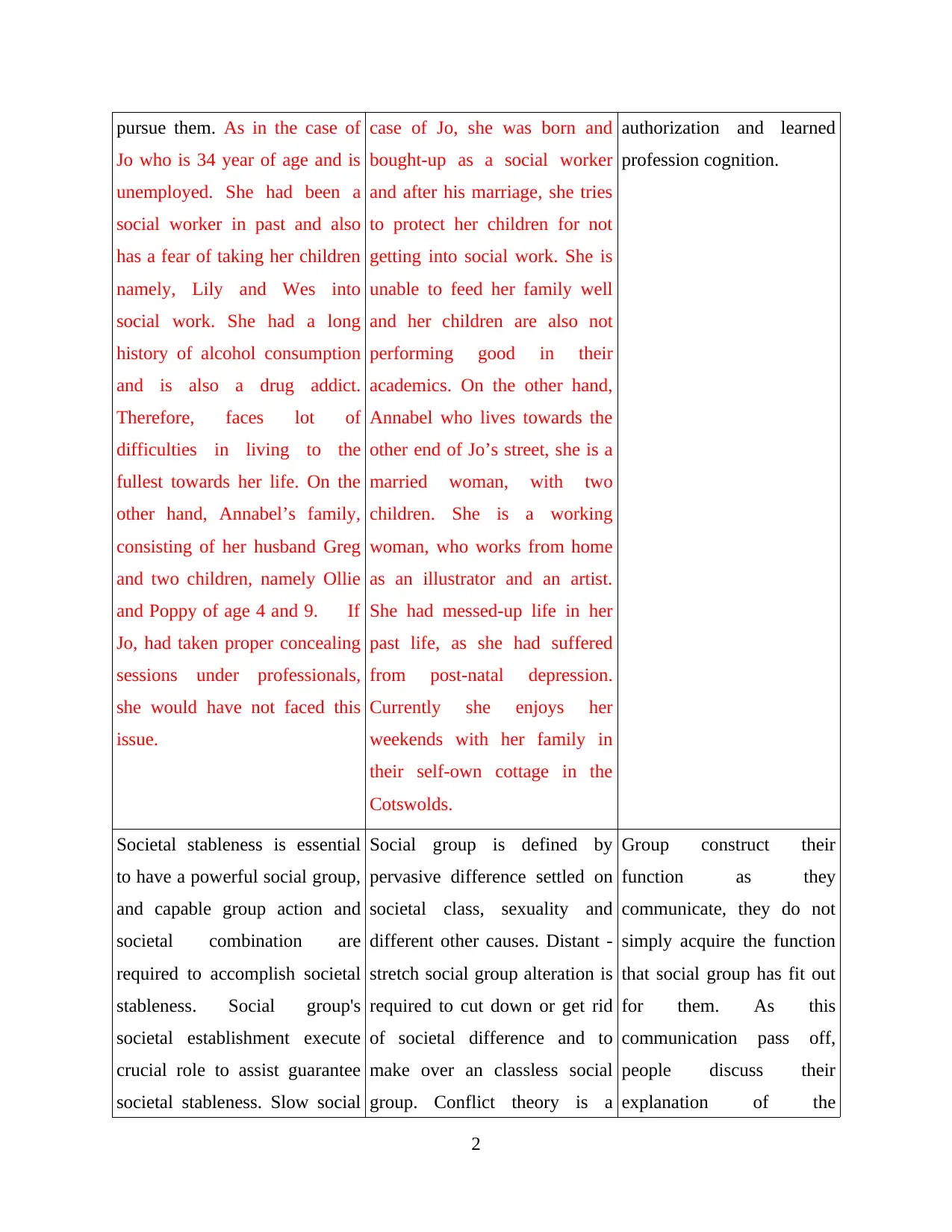
pursue them. As in the case of
Jo who is 34 year of age and is
unemployed. She had been a
social worker in past and also
has a fear of taking her children
namely, Lily and Wes into
social work. She had a long
history of alcohol consumption
and is also a drug addict.
Therefore, faces lot of
difficulties in living to the
fullest towards her life. On the
other hand, Annabel’s family,
consisting of her husband Greg
and two children, namely Ollie
and Poppy of age 4 and 9. If
Jo, had taken proper concealing
sessions under professionals,
she would have not faced this
issue.
case of Jo, she was born and
bought-up as a social worker
and after his marriage, she tries
to protect her children for not
getting into social work. She is
unable to feed her family well
and her children are also not
performing good in their
academics. On the other hand,
Annabel who lives towards the
other end of Jo’s street, she is a
married woman, with two
children. She is a working
woman, who works from home
as an illustrator and an artist.
She had messed-up life in her
past life, as she had suffered
from post-natal depression.
Currently she enjoys her
weekends with her family in
their self-own cottage in the
Cotswolds.
authorization and learned
profession cognition.
Societal stableness is essential
to have a powerful social group,
and capable group action and
societal combination are
required to accomplish societal
stableness. Social group's
societal establishment execute
crucial role to assist guarantee
societal stableness. Slow social
Social group is defined by
pervasive difference settled on
societal class, sexuality and
different other causes. Distant -
stretch social group alteration is
required to cut down or get rid
of societal difference and to
make over an classless social
group. Conflict theory is a
Group construct their
function as they
communicate, they do not
simply acquire the function
that social group has fit out
for them. As this
communication pass off,
people discuss their
explanation of the
2
Jo who is 34 year of age and is
unemployed. She had been a
social worker in past and also
has a fear of taking her children
namely, Lily and Wes into
social work. She had a long
history of alcohol consumption
and is also a drug addict.
Therefore, faces lot of
difficulties in living to the
fullest towards her life. On the
other hand, Annabel’s family,
consisting of her husband Greg
and two children, namely Ollie
and Poppy of age 4 and 9. If
Jo, had taken proper concealing
sessions under professionals,
she would have not faced this
issue.
case of Jo, she was born and
bought-up as a social worker
and after his marriage, she tries
to protect her children for not
getting into social work. She is
unable to feed her family well
and her children are also not
performing good in their
academics. On the other hand,
Annabel who lives towards the
other end of Jo’s street, she is a
married woman, with two
children. She is a working
woman, who works from home
as an illustrator and an artist.
She had messed-up life in her
past life, as she had suffered
from post-natal depression.
Currently she enjoys her
weekends with her family in
their self-own cottage in the
Cotswolds.
authorization and learned
profession cognition.
Societal stableness is essential
to have a powerful social group,
and capable group action and
societal combination are
required to accomplish societal
stableness. Social group's
societal establishment execute
crucial role to assist guarantee
societal stableness. Slow social
Social group is defined by
pervasive difference settled on
societal class, sexuality and
different other causes. Distant -
stretch social group alteration is
required to cut down or get rid
of societal difference and to
make over an classless social
group. Conflict theory is a
Group construct their
function as they
communicate, they do not
simply acquire the function
that social group has fit out
for them. As this
communication pass off,
people discuss their
explanation of the
2
Paraphrase This Document
Need a fresh take? Get an instant paraphrase of this document with our AI Paraphraser
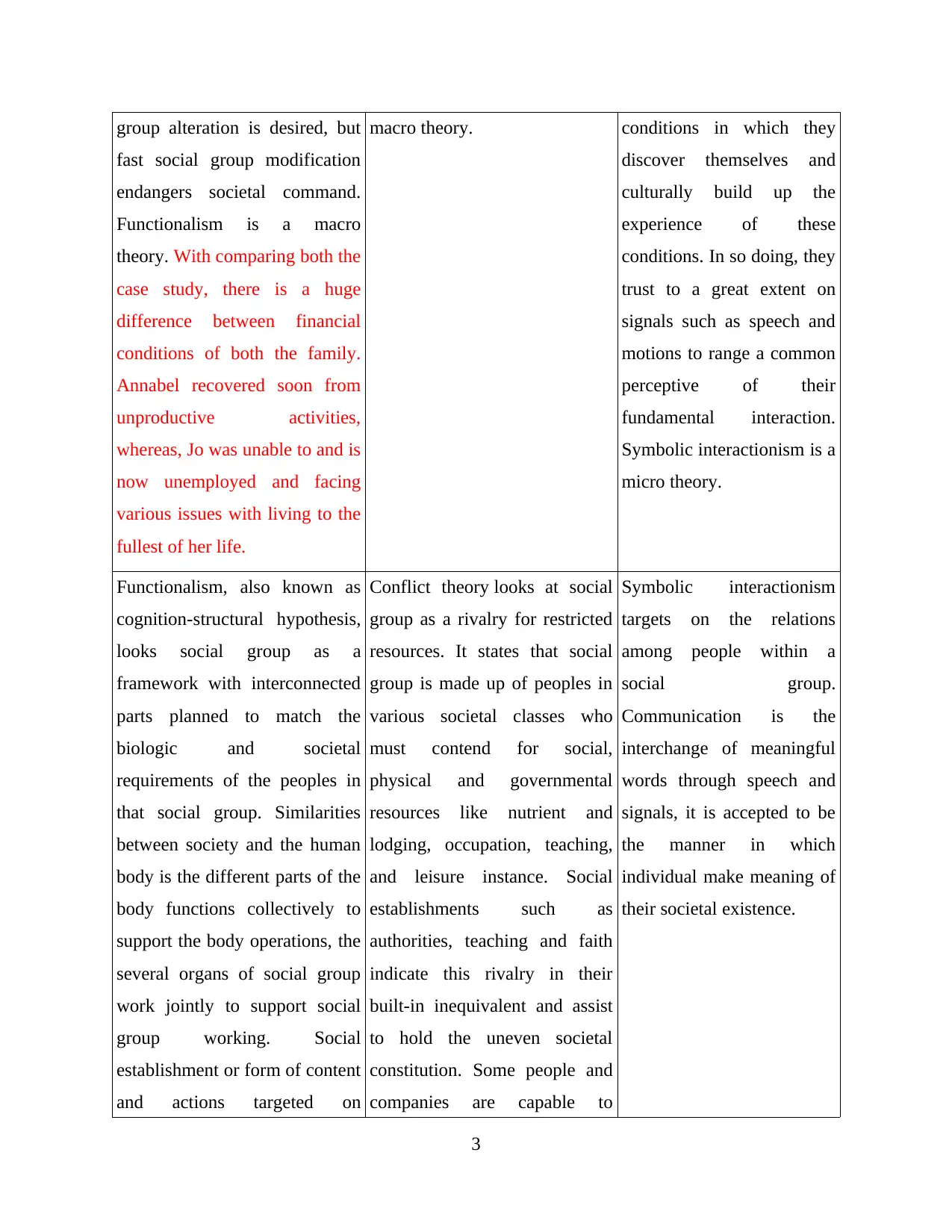
group alteration is desired, but
fast social group modification
endangers societal command.
Functionalism is a macro
theory. With comparing both the
case study, there is a huge
difference between financial
conditions of both the family.
Annabel recovered soon from
unproductive activities,
whereas, Jo was unable to and is
now unemployed and facing
various issues with living to the
fullest of her life.
macro theory. conditions in which they
discover themselves and
culturally build up the
experience of these
conditions. In so doing, they
trust to a great extent on
signals such as speech and
motions to range a common
perceptive of their
fundamental interaction.
Symbolic interactionism is a
micro theory.
Functionalism, also known as
cognition-structural hypothesis,
looks social group as a
framework with interconnected
parts planned to match the
biologic and societal
requirements of the peoples in
that social group. Similarities
between society and the human
body is the different parts of the
body functions collectively to
support the body operations, the
several organs of social group
work jointly to support social
group working. Social
establishment or form of content
and actions targeted on
Conflict theory looks at social
group as a rivalry for restricted
resources. It states that social
group is made up of peoples in
various societal classes who
must contend for social,
physical and governmental
resources like nutrient and
lodging, occupation, teaching,
and leisure instance. Social
establishments such as
authorities, teaching and faith
indicate this rivalry in their
built-in inequivalent and assist
to hold the uneven societal
constitution. Some people and
companies are capable to
Symbolic interactionism
targets on the relations
among people within a
social group.
Communication is the
interchange of meaningful
words through speech and
signals, it is accepted to be
the manner in which
individual make meaning of
their societal existence.
3
fast social group modification
endangers societal command.
Functionalism is a macro
theory. With comparing both the
case study, there is a huge
difference between financial
conditions of both the family.
Annabel recovered soon from
unproductive activities,
whereas, Jo was unable to and is
now unemployed and facing
various issues with living to the
fullest of her life.
macro theory. conditions in which they
discover themselves and
culturally build up the
experience of these
conditions. In so doing, they
trust to a great extent on
signals such as speech and
motions to range a common
perceptive of their
fundamental interaction.
Symbolic interactionism is a
micro theory.
Functionalism, also known as
cognition-structural hypothesis,
looks social group as a
framework with interconnected
parts planned to match the
biologic and societal
requirements of the peoples in
that social group. Similarities
between society and the human
body is the different parts of the
body functions collectively to
support the body operations, the
several organs of social group
work jointly to support social
group working. Social
establishment or form of content
and actions targeted on
Conflict theory looks at social
group as a rivalry for restricted
resources. It states that social
group is made up of peoples in
various societal classes who
must contend for social,
physical and governmental
resources like nutrient and
lodging, occupation, teaching,
and leisure instance. Social
establishments such as
authorities, teaching and faith
indicate this rivalry in their
built-in inequivalent and assist
to hold the uneven societal
constitution. Some people and
companies are capable to
Symbolic interactionism
targets on the relations
among people within a
social group.
Communication is the
interchange of meaningful
words through speech and
signals, it is accepted to be
the manner in which
individual make meaning of
their societal existence.
3
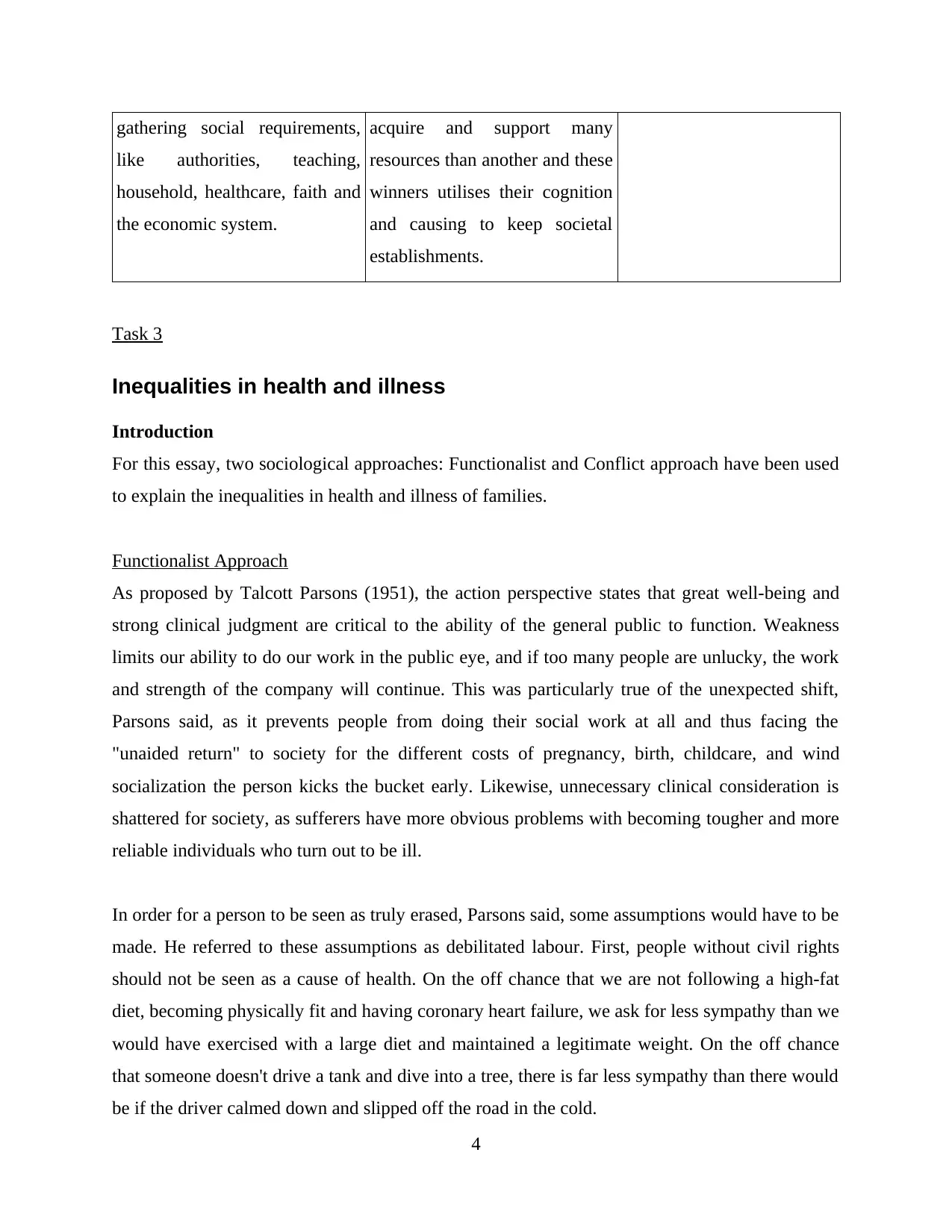
gathering social requirements,
like authorities, teaching,
household, healthcare, faith and
the economic system.
acquire and support many
resources than another and these
winners utilises their cognition
and causing to keep societal
establishments.
Task 3
Inequalities in health and illness
Introduction
For this essay, two sociological approaches: Functionalist and Conflict approach have been used
to explain the inequalities in health and illness of families.
Functionalist Approach
As proposed by Talcott Parsons (1951), the action perspective states that great well-being and
strong clinical judgment are critical to the ability of the general public to function. Weakness
limits our ability to do our work in the public eye, and if too many people are unlucky, the work
and strength of the company will continue. This was particularly true of the unexpected shift,
Parsons said, as it prevents people from doing their social work at all and thus facing the
"unaided return" to society for the different costs of pregnancy, birth, childcare, and wind
socialization the person kicks the bucket early. Likewise, unnecessary clinical consideration is
shattered for society, as sufferers have more obvious problems with becoming tougher and more
reliable individuals who turn out to be ill.
In order for a person to be seen as truly erased, Parsons said, some assumptions would have to be
made. He referred to these assumptions as debilitated labour. First, people without civil rights
should not be seen as a cause of health. On the off chance that we are not following a high-fat
diet, becoming physically fit and having coronary heart failure, we ask for less sympathy than we
would have exercised with a large diet and maintained a legitimate weight. On the off chance
that someone doesn't drive a tank and dive into a tree, there is far less sympathy than there would
be if the driver calmed down and slipped off the road in the cold.
4
like authorities, teaching,
household, healthcare, faith and
the economic system.
acquire and support many
resources than another and these
winners utilises their cognition
and causing to keep societal
establishments.
Task 3
Inequalities in health and illness
Introduction
For this essay, two sociological approaches: Functionalist and Conflict approach have been used
to explain the inequalities in health and illness of families.
Functionalist Approach
As proposed by Talcott Parsons (1951), the action perspective states that great well-being and
strong clinical judgment are critical to the ability of the general public to function. Weakness
limits our ability to do our work in the public eye, and if too many people are unlucky, the work
and strength of the company will continue. This was particularly true of the unexpected shift,
Parsons said, as it prevents people from doing their social work at all and thus facing the
"unaided return" to society for the different costs of pregnancy, birth, childcare, and wind
socialization the person kicks the bucket early. Likewise, unnecessary clinical consideration is
shattered for society, as sufferers have more obvious problems with becoming tougher and more
reliable individuals who turn out to be ill.
In order for a person to be seen as truly erased, Parsons said, some assumptions would have to be
made. He referred to these assumptions as debilitated labour. First, people without civil rights
should not be seen as a cause of health. On the off chance that we are not following a high-fat
diet, becoming physically fit and having coronary heart failure, we ask for less sympathy than we
would have exercised with a large diet and maintained a legitimate weight. On the off chance
that someone doesn't drive a tank and dive into a tree, there is far less sympathy than there would
be if the driver calmed down and slipped off the road in the cold.
4
⊘ This is a preview!⊘
Do you want full access?
Subscribe today to unlock all pages.

Trusted by 1+ million students worldwide
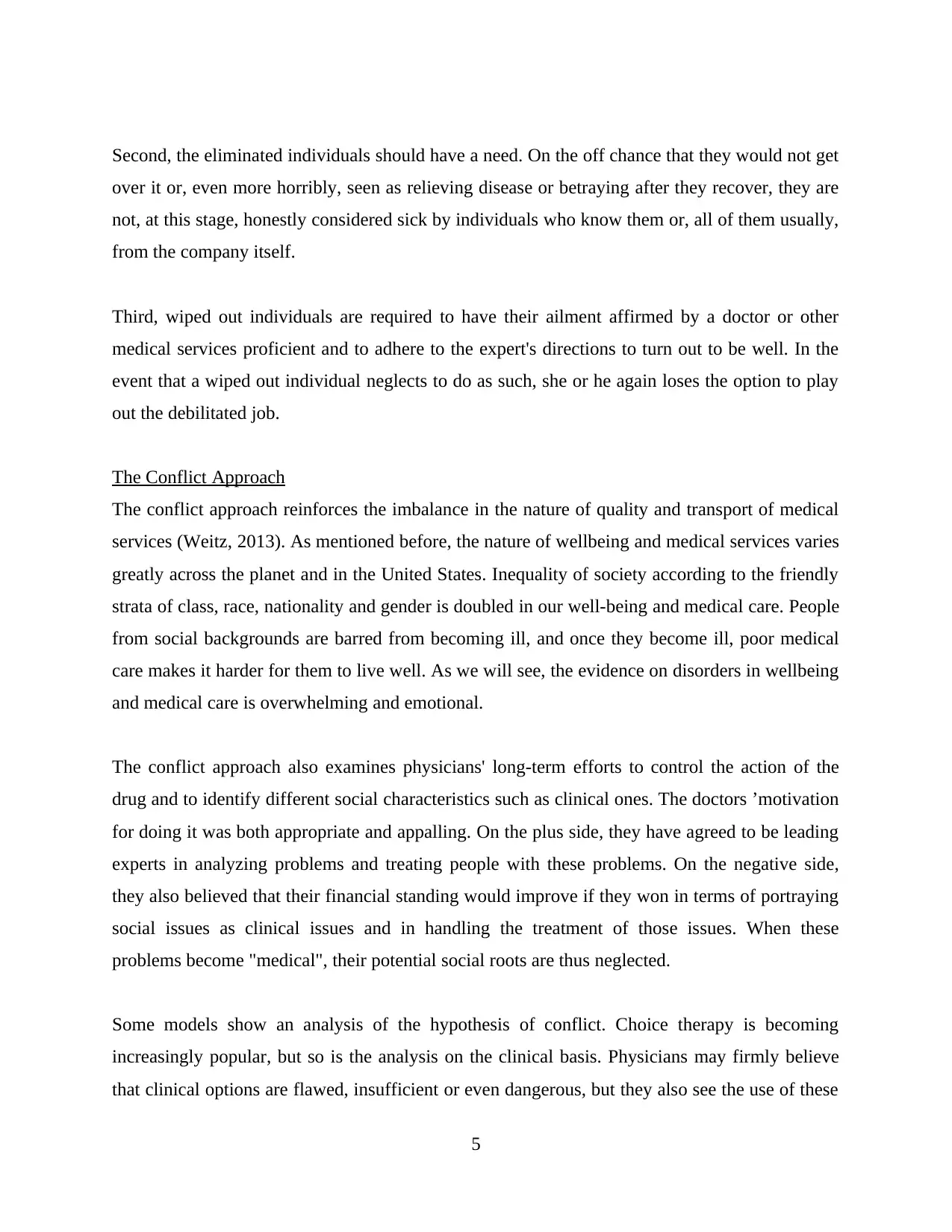
Second, the eliminated individuals should have a need. On the off chance that they would not get
over it or, even more horribly, seen as relieving disease or betraying after they recover, they are
not, at this stage, honestly considered sick by individuals who know them or, all of them usually,
from the company itself.
Third, wiped out individuals are required to have their ailment affirmed by a doctor or other
medical services proficient and to adhere to the expert's directions to turn out to be well. In the
event that a wiped out individual neglects to do as such, she or he again loses the option to play
out the debilitated job.
The Conflict Approach
The conflict approach reinforces the imbalance in the nature of quality and transport of medical
services (Weitz, 2013). As mentioned before, the nature of wellbeing and medical services varies
greatly across the planet and in the United States. Inequality of society according to the friendly
strata of class, race, nationality and gender is doubled in our well-being and medical care. People
from social backgrounds are barred from becoming ill, and once they become ill, poor medical
care makes it harder for them to live well. As we will see, the evidence on disorders in wellbeing
and medical care is overwhelming and emotional.
The conflict approach also examines physicians' long-term efforts to control the action of the
drug and to identify different social characteristics such as clinical ones. The doctors ’motivation
for doing it was both appropriate and appalling. On the plus side, they have agreed to be leading
experts in analyzing problems and treating people with these problems. On the negative side,
they also believed that their financial standing would improve if they won in terms of portraying
social issues as clinical issues and in handling the treatment of those issues. When these
problems become "medical", their potential social roots are thus neglected.
Some models show an analysis of the hypothesis of conflict. Choice therapy is becoming
increasingly popular, but so is the analysis on the clinical basis. Physicians may firmly believe
that clinical options are flawed, insufficient or even dangerous, but they also see the use of these
5
over it or, even more horribly, seen as relieving disease or betraying after they recover, they are
not, at this stage, honestly considered sick by individuals who know them or, all of them usually,
from the company itself.
Third, wiped out individuals are required to have their ailment affirmed by a doctor or other
medical services proficient and to adhere to the expert's directions to turn out to be well. In the
event that a wiped out individual neglects to do as such, she or he again loses the option to play
out the debilitated job.
The Conflict Approach
The conflict approach reinforces the imbalance in the nature of quality and transport of medical
services (Weitz, 2013). As mentioned before, the nature of wellbeing and medical services varies
greatly across the planet and in the United States. Inequality of society according to the friendly
strata of class, race, nationality and gender is doubled in our well-being and medical care. People
from social backgrounds are barred from becoming ill, and once they become ill, poor medical
care makes it harder for them to live well. As we will see, the evidence on disorders in wellbeing
and medical care is overwhelming and emotional.
The conflict approach also examines physicians' long-term efforts to control the action of the
drug and to identify different social characteristics such as clinical ones. The doctors ’motivation
for doing it was both appropriate and appalling. On the plus side, they have agreed to be leading
experts in analyzing problems and treating people with these problems. On the negative side,
they also believed that their financial standing would improve if they won in terms of portraying
social issues as clinical issues and in handling the treatment of those issues. When these
problems become "medical", their potential social roots are thus neglected.
Some models show an analysis of the hypothesis of conflict. Choice therapy is becoming
increasingly popular, but so is the analysis on the clinical basis. Physicians may firmly believe
that clinical options are flawed, insufficient or even dangerous, but they also see the use of these
5
Paraphrase This Document
Need a fresh take? Get an instant paraphrase of this document with our AI Paraphraser
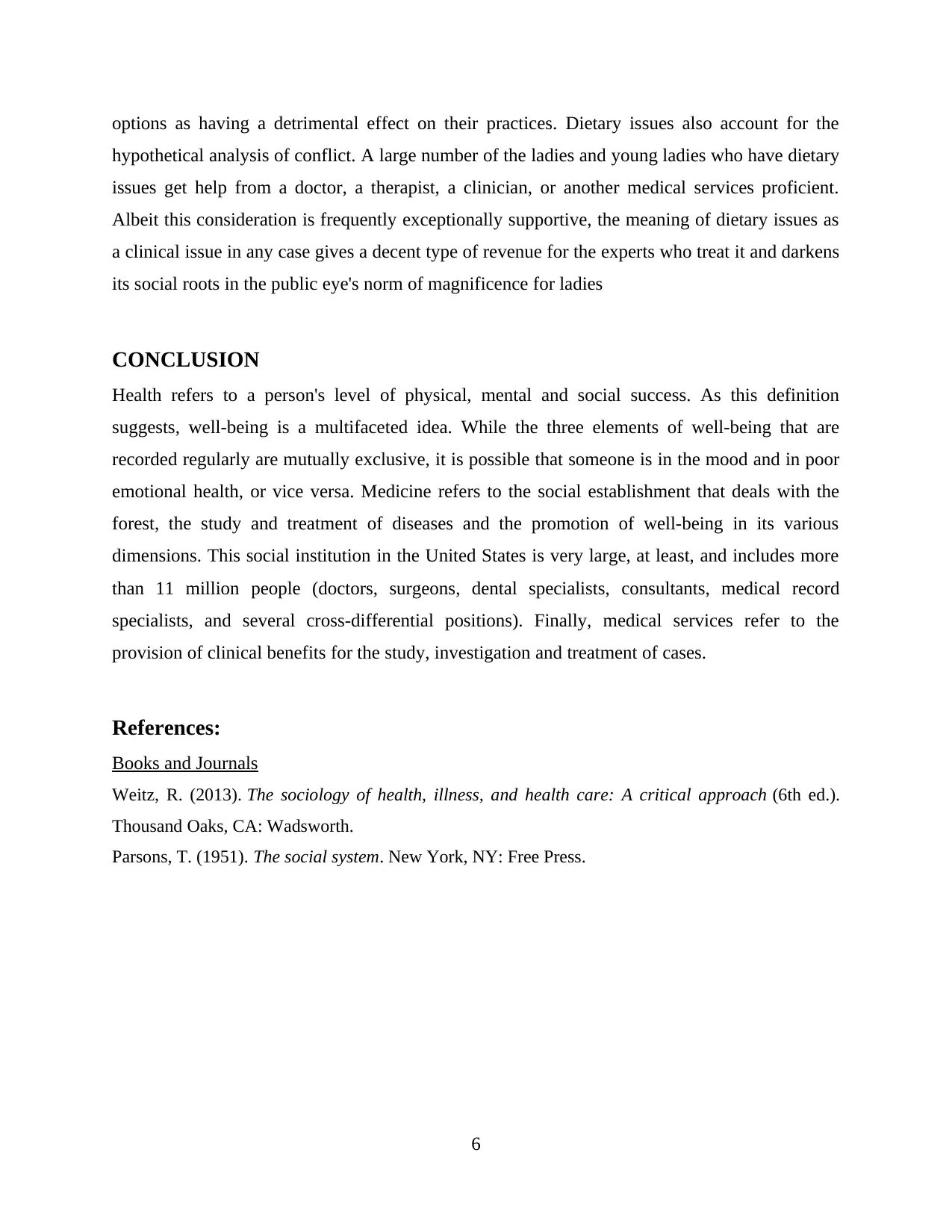
options as having a detrimental effect on their practices. Dietary issues also account for the
hypothetical analysis of conflict. A large number of the ladies and young ladies who have dietary
issues get help from a doctor, a therapist, a clinician, or another medical services proficient.
Albeit this consideration is frequently exceptionally supportive, the meaning of dietary issues as
a clinical issue in any case gives a decent type of revenue for the experts who treat it and darkens
its social roots in the public eye's norm of magnificence for ladies
CONCLUSION
Health refers to a person's level of physical, mental and social success. As this definition
suggests, well-being is a multifaceted idea. While the three elements of well-being that are
recorded regularly are mutually exclusive, it is possible that someone is in the mood and in poor
emotional health, or vice versa. Medicine refers to the social establishment that deals with the
forest, the study and treatment of diseases and the promotion of well-being in its various
dimensions. This social institution in the United States is very large, at least, and includes more
than 11 million people (doctors, surgeons, dental specialists, consultants, medical record
specialists, and several cross-differential positions). Finally, medical services refer to the
provision of clinical benefits for the study, investigation and treatment of cases.
References:
Books and Journals
Weitz, R. (2013). The sociology of health, illness, and health care: A critical approach (6th ed.).
Thousand Oaks, CA: Wadsworth.
Parsons, T. (1951). The social system. New York, NY: Free Press.
6
hypothetical analysis of conflict. A large number of the ladies and young ladies who have dietary
issues get help from a doctor, a therapist, a clinician, or another medical services proficient.
Albeit this consideration is frequently exceptionally supportive, the meaning of dietary issues as
a clinical issue in any case gives a decent type of revenue for the experts who treat it and darkens
its social roots in the public eye's norm of magnificence for ladies
CONCLUSION
Health refers to a person's level of physical, mental and social success. As this definition
suggests, well-being is a multifaceted idea. While the three elements of well-being that are
recorded regularly are mutually exclusive, it is possible that someone is in the mood and in poor
emotional health, or vice versa. Medicine refers to the social establishment that deals with the
forest, the study and treatment of diseases and the promotion of well-being in its various
dimensions. This social institution in the United States is very large, at least, and includes more
than 11 million people (doctors, surgeons, dental specialists, consultants, medical record
specialists, and several cross-differential positions). Finally, medical services refer to the
provision of clinical benefits for the study, investigation and treatment of cases.
References:
Books and Journals
Weitz, R. (2013). The sociology of health, illness, and health care: A critical approach (6th ed.).
Thousand Oaks, CA: Wadsworth.
Parsons, T. (1951). The social system. New York, NY: Free Press.
6
1 out of 8
Related Documents
Your All-in-One AI-Powered Toolkit for Academic Success.
+13062052269
info@desklib.com
Available 24*7 on WhatsApp / Email
![[object Object]](/_next/static/media/star-bottom.7253800d.svg)
Unlock your academic potential
Copyright © 2020–2025 A2Z Services. All Rights Reserved. Developed and managed by ZUCOL.





